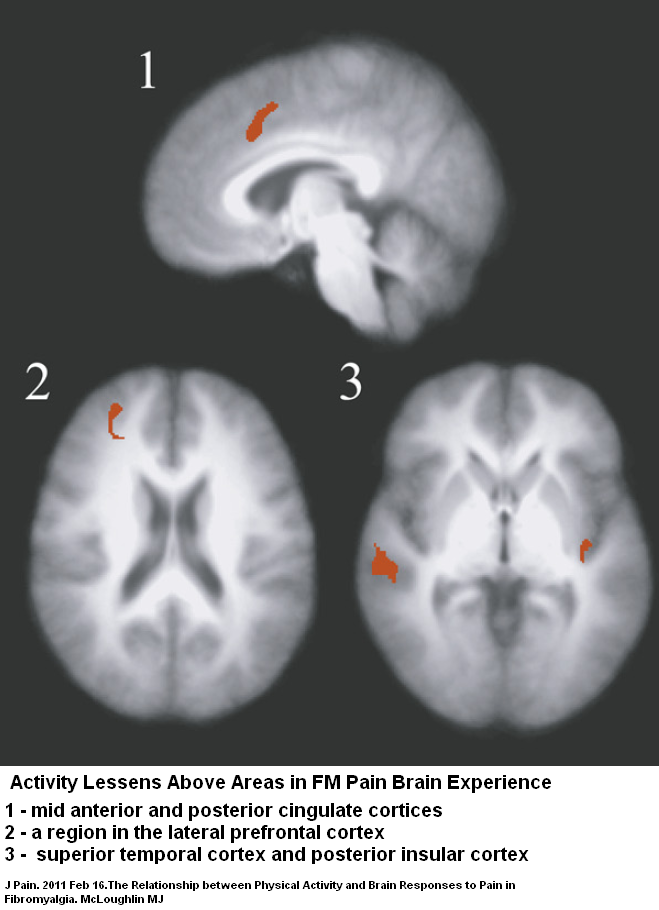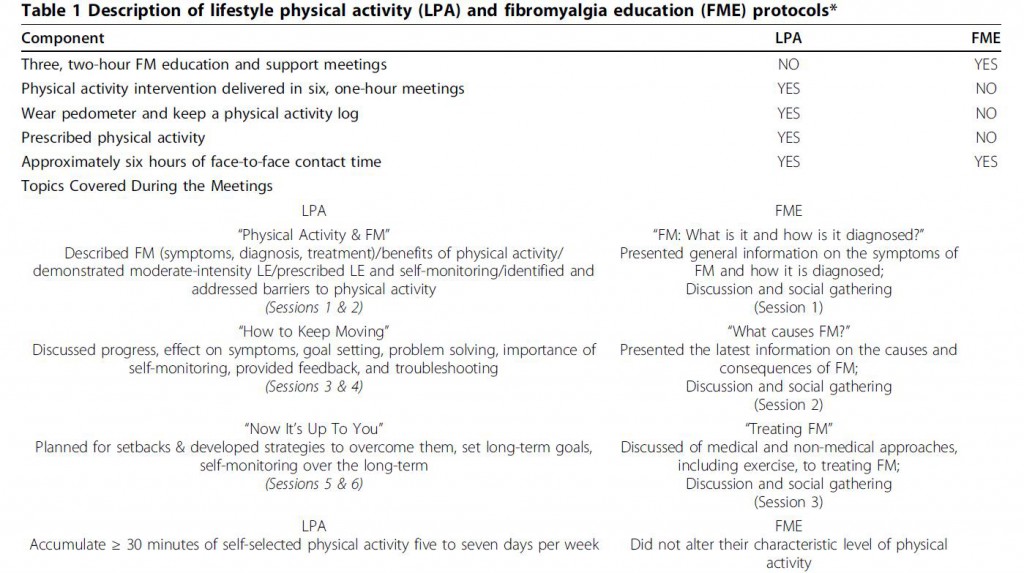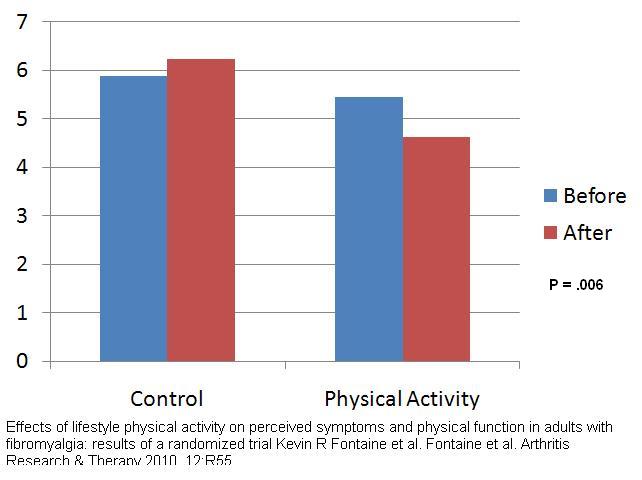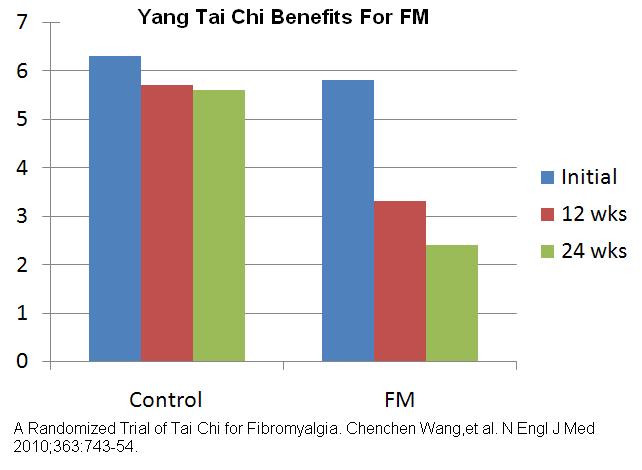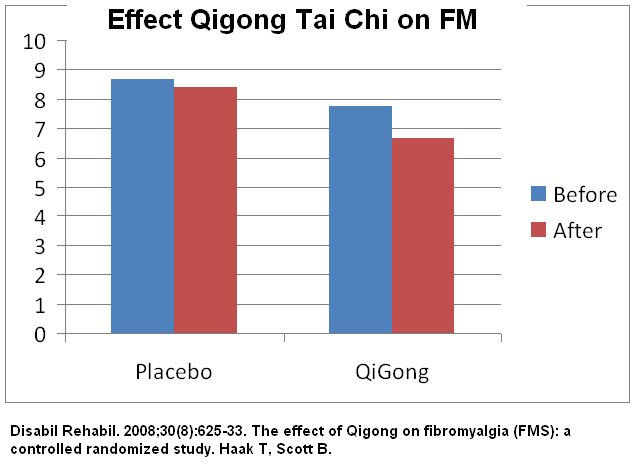Only 1/2 of studies show pain benefits in FM from exercise. Most exercise trails are short term (12-20 weeks) and a recent long term study failed to show benefits on followup. Is the idea “all you need is exercise” just hype?
My daughter and I are doing a survey of women with Fibromyalgia. If you could be kind as to click here:
FM Survey
Physical activity has been recently shown to help the brain maintain brain network control over the pain:
J. Pain. 2011 Feb 16. [Epub ahead of print]
The Relationship between Physical Activity and Brain Responses to Pain in Fibromyalgia.
McLoughlin MJ, Stegner AJ, Cook DB. abstract here
Results have been varied whether exercise helps pain or not:
” Eight studies found a significant reduction in spontaneous pain (VAS) and/or the number of TPs and myalgic score, in comparison with both untreated controls and other types
of exercise. However, it must be emphasised that seven studies found no significant differences.”
What kind of exercise is best in fibromyalgia therapeutic programmes? A practical review
M. Cazzola1, F. Atzeni2, F. Salaffi3, S. Stisi4, G. Cassisi5, P. Sarzi-Puttini
Clin Exp Rheumatol 2010; 28 (Suppl. 63): S117-S124. abstract here
Types Of Exercises
Walking – The question is whether exercise helps the pain or helps stamina and quality of life: – For example with speed walking.
In:
Does moderate-to-high intensity Nordic walking improve functional capacity and pain in fibromyalgia? A prospective randomized controlled trial
Kaisa Mannerkorpi1,2*, Lena Nordeman3,4, Åsa Cider5,2, Gunilla Jonsson
Arthritis Research & Therapy 2010, 12:R189 free article here
- Intervention was exercise sessions twice a week for 15 weeks. The target was to achieve 20 minutes of moderate-to-high intensity exercise –
walking as quickly as possible but not running- “Moderate” was considered 40-60% of your maximal heart rate. - There was a 14% drop out rate which is lower than some FM exercise studies because they they whittled down 239 patients to 67 “go-getters” for the study – this might not give real world results.
- FIQ physical Functioning improved 18% (p=0.004)in the high speed wallking group versus 3% (p=0.027) in the slow walking group. The questions included:

- The low speed walking was still significantly better and there was a wide variation so please at least walk around the block everyday anyway…
- 6 minute walk test was 3% better in the fast walk group (p< 0.001and 1.6% better in the slow group(P=0.009) with 3 and 9 beats per minute decreases in heart rate immediately after.
- Motivation improved in the low walk group (p=0.031) suggesting it helped get lives together some…
- Missing was any effect on pain scores…
——————————————————————–
Water Exercises
There is a getter tolerance for water exercises. They use floatation devices and do exercises in water. There are two such groups in Regina:
– Water Moves at the south east leisure centre
– Arthritis society program at Wascana hospital (warmer but long waiting list)
—————————————————————————————–
Rushing About
Even minimal exertions can have beneficial results:
Effects of lifestyle physical activity on perceived symptoms and physical function in adults with fibromyalgia: results of a randomized trial
Kevin R Fontaine1*, Lora Conn1, Daniel J Clauw
Fontaine et al. Arthritis Research & Therapy 2010, 12:R55 free article here
- Short Bursts of Physical Activity May Reduce Fibromyalgia Symptoms – if one can do everything fast paced so is winded throught the day so it adds up to 30 minutes – 5 to 7 days per week.
- The reality of the situation was that there was more than just the exercise – there was an “educational program” that I suspect was support,motivational and goal oriented:
- There was a 54% increase in the number of steps taken – double the activity
- Results pain wise were more encouraging: – that’s a 15% decrease in pain – not the needed 30% reduction needed for substantial relief, but a good add-on to other measures.
- An 18% drop (p=0.032) in FIQ functional disability (I guess over 14% is considered meaningful)
- Hence “short bouts of activity throughout the day can markedly increase the average number of steps taken per day and produces clinically relevant reductions in perceived functional deficits and pain.”
______________________________________________________________________
Tai Chi
-
Recent Article on Yang Style Tai Chi found significant benefits:
A Randomized Trial of Tai Chi for Fibromyalgia
Chenchen Wang, M.D., M.P.H., Christopher H. Schmid, Ph.D., Ramel Rones, B.S., Robert Kalish, M.D., Janeth Yinh, M.D., Don L. Goldenberg, M.D., Yoojin Lee, M.S., and Timothy McAlindon, M.D., M.P.H.
N Engl J Med 2010;363:743-54. free article here
12 weeks twice weekly
Control group was given the works:
A pain clinic style educational program – “At each session, a variety of health professionals provided a 40-minute didactic lesson on a topic relating to fibromyalgia, including the diagnostic criteria; coping strategies and problem-solving techniques; diet and nutrition; sleep disorders and fibromyalgia; pain management, therapies, and medications; physical and mental health; exercise; and wellness and lifestyle management.”Additional exercise program:- “For the final 20 minutes of each class, participants practiced stretching exercises supervised by the research staff. Stretches involved the upper body, trunk, and lower body and were held for 15 to 20 seconds.”
Daily adherence – Participants were instructed to practice stretching at home for 20 minutes a day. – Had to keep a daily log of efforts!
Tai chi was 60 minutes Yang style tai chi including:
- each session included a warm-up and self-massagereview of principles, movementsbreathing techniques relaxation in tai chi. participants were instructed to practice tai chi at home for at least 20 minutes each day
Results on Pain:
A prior Tai Chi study was not as enthusiastic:
One wonders if the insistance on daily work and the other add-on in the initial study made the difference.
———————————————————-
What is the best exercise program? – The vote is still out if water based are superior, but what seems clear as the workload must not be sufficent to not exacerbate post-exercise pain:
Clin Exp Rheumatol. 2010 Nov-Dec;28(6 Suppl 63):S117-24. Epub 2010 Dec 22.
Which kind of exercise is best in fibromyalgia therapeutic programmes? A practical review.
Cazzola M, Atzeni F, Salaffi F, Stisi S, Cassisi G, Sarzi-Puttini P. abstract here
Does it Last? Maybe No-
J Clin Rheumatol. 2011 Feb 10. [Epub ahead of print]
Effects of Lifestyle Physical Activity in Adults With Fibromyalgia: Results at Follow-Up.
Fontaine KR, Conn L, Clauw DJ. abstract here
- “CONCLUSIONS: Although participants reported greater perceived improvement at each assessment, the beneficial effects of LPA (lifestyle physical activity) on physical activity, function, and pain found after the 12-week intervention were not sustained over time.” as for Tai Chi, I (not FM) am a Tai Chi drop in- drop out – maintaining Tai chi is almost impossible…
Comments – Well, from listening to talks and rheumaologists, you would think exercise is the holy grail for FM pain. Well, it look like it will have maybe a 50% chance of working (8 positive vs 7 negative studies), and it may only last as long as the patient is willing to maintain the program. Boy that’s depressing. It, however. supports the idea that in FM multiple measures need to be undertaken at the same time to gain benefits. I talked to a lady how has been going to the gym for 20 years. She has never woken up once wanting to go… Most of the studies in FM exercise are not real world studies – they are on unique go getters solicited by newspaper or from support groups – and the run for 12 + weeks. They do not represent the usual FM patient that has comorbidities that restrict activity, and have emotional elements that make sustained workouts unlikely.
The exercise king may be dead… what will rise in its place?
I’m hoping this generates some discussion….
The found
1) The exercise does not have to be long
J Appl Physiol. 2005 Jun;98(6):1985-90.
Six sessions of sprint interval training increases muscle oxidative potential and cycle endurance capacity in humans.
Burgomaster KA, Hughes SC, Heigenhauser GJ, Bradwell SN, Gibala MJ. free article here
- As little as Four 30 second all out exercise a day can increase stamina 100% in one week compared to controls. The did them 4 minutes apart but I suspect they could be spread over the day with impact.
OK Who is going to be able to do that? Just extra fast rushing around doing normal activities in spurts ( enough to make you winded) over the course of a day will give significant relief of FM symptoms:

